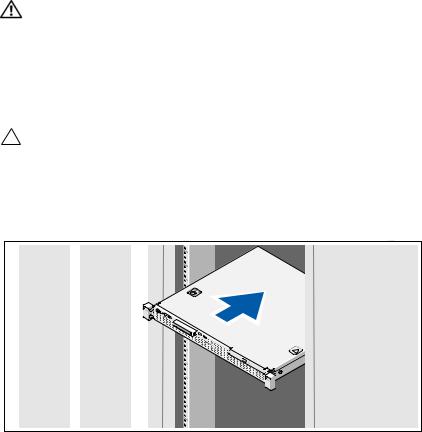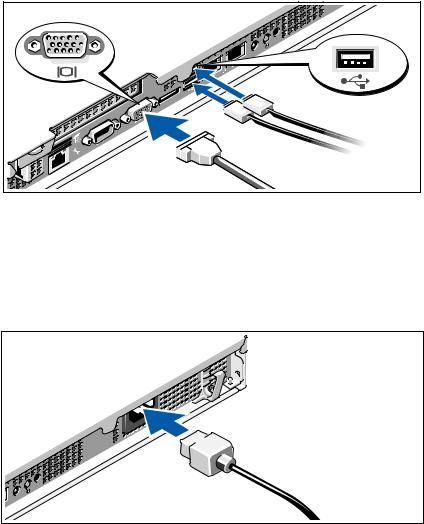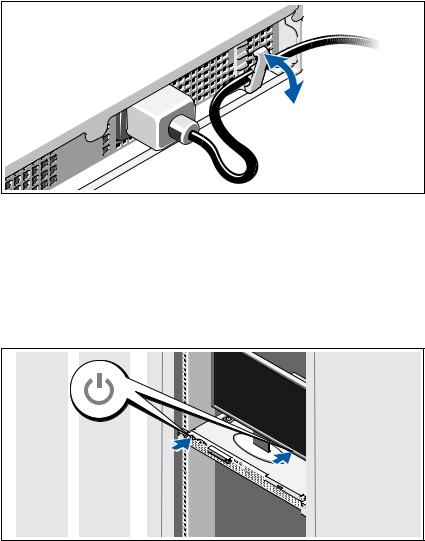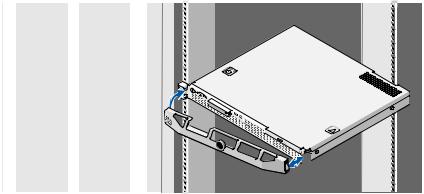Dell E10S, E10S001, U499M User Manual

Dell™ PowerEdge™
R210 Systems
Getting Started
With Your System
Guide de mise en route
Primeiros passos com o sistema
Procedimientos iniciales con el sistema
Dell™ PowerEdge™
R210 Systems
Getting Started
With Your System
Regulatory Model E10S
Regulatory Type E10S001
w w w . d e l l . c o m | s u p p o r t . d e l l . c o m

Notes, Cautions, and Warnings
NOTE: A NOTE indicates important information that helps you make better use of your computer.
CAUTION: A CAUTION indicates potential damage to hardware or loss of data if instructions are not followed.
WARNING: A WARNING indicates a potential for property damage, personal injury, or death.
____________________
Information in this document is subject to change without notice. © 2009 Dell Inc. All rights reserved.
Reproduction of these materials in any manner whatsoever without the written permission of Dell Inc. is strictly forbidden.
Trademarks used in this text: Dell, the DELL logo, and PowerEdge are trademarks of Dell Inc.; Intel and Xeon are registered trademarks of Intel Corporation in the U.S. and other countries; Microsoft, Hyper-V, Windows, and Windows Server are either trademarks or registered trademarks of Microsoft Corporation in the United States and/or other countries; Red Hat and Red Hat Enterprise Linux are registered trademarks of Red Hat, Inc. in the United States and other countries; SUSE is a registered trademark of Novell, Inc. in the United States and other countries.
Other trademarks and trade names may be used in this document to refer to either the entities claiming the marks and names or their products. Dell Inc. disclaims any proprietary interest in trademarks and trade names other than its own.
Regulatory Model E10S
Regulatory Type E10S001
June 2009 |
P/N U499M |
Rev. A01 |

Installation and Configuration
WARNING: Before performing the following procedure, review the safety instructions that came with the system.
Unpacking the System
Unpack your system and identify each item.
Installing the Rails and System in a Rack
CAUTION: If installed in a closed or multi-unit rack assembly, the operating ambient temperature of the rack environment may be greater than room ambient. Therefore, consideration should be given to installing the equipment in an environment compatible with the maximum ambient temperature (Tma) specified by the manufacturer. For more information, see "Technical Specifications" on page 8.
Assemble the rails and install the system in the rack following the safety instructions and the rack installation instructions provided with your system.
Getting Started With Your System |
|
3 |
|

Optional – Connecting the Keyboard, Mouse, and Monitor
Connect the keyboard, mouse, and monitor (optional).
The connectors on the back of your system have icons indicating which cable to plug into each connector. Be sure to tighten the screws (if any) on the monitor's cable connector.
Connecting the Power Cable
Connect the system’s power cable to the system and, if a monitor is used, connect the monitor’s power cable to the monitor.
4 |
Getting Started With Your System |

Securing the Power Cable
Bend the system power cable as shown in the illustration and secure the cable in the retention clip.
Plug the other end of the power cable into a grounded electrical outlet or a separate power source such as an uninterrupted power supply (UPS) or a power distribution unit (PDU).
Turning On the System
Press the power button on the system and the monitor. The power indicators should light.
Getting Started With Your System |
|
5 |
|

Installing the Optional Bezel
Install the bezel (optional).
Complete the Operating System Setup
If you purchased a preinstalled operating system, see the operating system documentation that ships with your system. To install an operating system for the first time, see the installation and configuration documentation for your operating system. Be sure the operating system is installed before installing hardware or software not purchased with the system.
Supported Operating Systems
•Microsoft® Windows Server® 2008 R2 (x64) Web, Standard, Foundation, and Enterprise Editions
•Microsoft Windows Server 2008 SP2 (x86) Web, Standard, and Enterprise Editions
•Microsoft Windows Server 2008 SP2 (x64) Web, Standard, and Enterprise Editions
•Microsoft Windows Server 2008 x32-bit (x86) Web, Standard, and Enterprise Editions
•Microsoft Windows Server 2008 (x64) Web, Standard, Foundation, and Enterprise Editions
6 |
Getting Started With Your System |

•Microsoft Windows Small Business Server 2008 (x64) Standard and Premium Editions
•Microsoft Windows® Essential Business Server (x64) Standard and Premium Editions
•Microsoft Windows Server 2003 R2 32-bit (x86) Standard and Enterprise Editions
•Microsoft Windows Server 2003 R2 (x64) Standard and Enterprise Editions
•Microsoft Windows Server® 2008 Hyper-V™
•Microsoft Hyper-V Server 2008
•Red Hat® Enterprise Linux® 5.3 (x86_64)
•Red Hat Enterprise Linux 5.3 (x86)
•SUSE® Linux Enterprise Server 11 (x86_64)
NOTE: For the latest information on supported operating systems, see www.dell.com.
Other Information You May Need
WARNING: See the safety and regulatory information that shipped with your system. Warranty information may be included within this document or as a separate document.
•The rack documentation included with your rack solution describes how to install your system into a rack.
•The Hardware Owner’s Manual provides information about system features and describes how to troubleshoot the system and install or replace system components. This document is available online at support.dell.com/manuals.
•Any media that ships with your system that provides documentation and tools for configuring and managing your system, including those pertaining to the operating system, system management software, system updates, and system components that you purchased with your system.
NOTE: Always check for updates on support.dell.com/manuals and read the updates first because they often supersede information in other documents.
Getting Started With Your System |
|
7 |
|

Obtaining Technical Assistance
If you do not understand a procedure in this guide or if the system does not perform as expected, see your Hardware Owner’s Manual. Dell™ offers comprehensive hardware training and certification. See www.dell.com/training for more information. This service may not be offered in all locations.
Technical Specifications
Processor
Processor type |
Intel® Xeon® processor 3400 series |
|
|
Expansion Bus |
|
|
|
Bus type |
PCI Express Generation 2 |
Expansion slots |
One full-height, half-length x16 link |
|
|
Memory |
|
|
|
Architecture |
1066 and 1333 MHz DDR3 unbuffered |
|
Error Correcting Code (ECC) DIMMs |
Memory module sockets |
Four 240-pin |
Memory module capacities |
1 GB, 2 GB, or 4GB |
Minimum RAM |
1 GB |
Maximum RAM |
16 GB |
|
|
Drives |
|
|
|
Hard drives |
Up to two 3.5-inch cabled SAS or |
|
SATA internal drives |
|
or |
|
Up to two 2.5-inch cabled SAS, SATA, or |
|
SSD internal drives |
Optical drive |
One optional internal slimline |
|
SATA DVD-ROM or DVD+/-RW drive |
|
NOTE: DVD devices are data only |
|
Optional external USB DVD-ROM |
8 |
Getting Started With Your System |

Connectors
Back |
|
NIC |
Two RJ-45 (for integrated 1-GB NICs) |
Serial |
9-pin, DTE, 16550-compatible |
USB |
Two 4-pin, USB 2.0-compliant |
Video |
15-pin VGA |
eSATA |
One 7-pin connector |
Front |
|
Video |
15-pin VGA |
USB |
Two 4-pin, USB 2.0-compliant |
Internal |
|
USB |
Two 4-pin, USB 2.0-compliant |
|
|
Video |
|
|
|
Video type |
Matrox G200, integrated in Winbond WPCM450 |
Video memory |
8 MB |
Power
AC power supply (per power supply)
Wattage |
250 W |
Voltage |
100-240 VAC, 50/60 Hz, 4-2 A |
Heat dissipation |
1039 BTU/hr maximum |
Maximum inrush current |
Under typical line conditions and over the entire |
|
system ambient operating range, the inrush |
|
current may reach 25 A |
Batteries |
|
System battery |
CR 2032 3.0-V lithium ion coin cell |
Getting Started With Your System |
|
9 |
|

Physical
Height |
4.24 cm (1.67 in) |
Width |
43.4 cm (17.09 in) |
Depth |
39.37 cm (15.5 in) |
Weight (maximum configuration) |
8.058 kg (17.77 lb) |
Environmental
NOTE: For additional information about environmental measurements for specific system configurations, see www.dell.com/environmental_datasheets.
Temperature |
|
Operating |
10° to 35°C (50° to 95°F) with a maximum |
|
temperature gradation of 10°C per hour |
|
NOTE: For altitudes above 2950 feet, the maximum |
|
operating temperature is derated 1ºF/550 ft. |
Storage |
–40° to 65°C (–40° to 149°F) with a maximum |
|
temperature gradation of 20°C per hour |
Relative humidity |
|
Operating |
20% to 80% (noncondensing) with a maximum |
|
humidity gradation of 10% per hour |
Storage |
5% to 95% (noncondensing) |
Maximum vibration |
|
Operating |
0.26 Grms at 5–350 Hz for 15 min |
Storage |
1.54 Grms at 10–250 Hz for 15 min |
10 |
Getting Started With Your System |

Environmental (continued)
Maximum shock
Operating |
One shock pulse in the positive z axis (one pulse |
|
on each side of the system) of 31 G for 2.6 ms in |
|
the operational orientation |
Storage |
Six consecutively executed shock pulses in |
|
the positive and negative x, y, and z axes |
|
(one pulse on each side of the system) of 71 G |
|
for up to 2 ms |
|
Six consecutively executed shock pulses in |
|
the positive and negative x, y, and z axes |
|
(one pulse on each side of the system) of 32 G |
|
faired square wave pulse with velocity change at |
|
270 inches/second (686 centimeters/second) |
Altitude |
|
Operating |
–16 to 3048 m (–50 to 10,000 ft) |
|
NOTE: For altitudes above 2950 feet, the maximum |
|
operating temperature is derated 1ºF/550 ft. |
Storage |
–16 to 10,600 m (–50 to 35,000 ft) |
Airborne Contaminant Level |
|
Class |
G2 or lower as defined by ISA-S71.04-1985 |
Getting Started With Your System |
|
11 |
|
12 |
Getting Started With Your System |
Systèmes Dell™
PowerEdge™ R210
Guide de mise en route
Modèle de régulation E10S
Type de régulation E10S001
w w w . d e l l . c o m | s u p p o r t . d e l l . c o m
